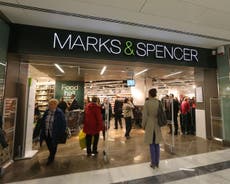Marks and Spencer used to be the retailer of choice for the small-town social climber – now it's just another shop
In the early 1980s you knew you were in a respectable household if they offered you a slice of cake from M&S. My mam and gran knew this well
To my mam and my gran, the food hall of our local Marks and Spencer was a place of worship. Neither of them were churchgoers, but they believed fervently in the cult of M&S brand St Michael.
Every Saturday they’d drag me into “Marksies” on King Street in South Shields to cram their baskets with delicacies that just weren’t the same in Safeway up the road. Continental cold meats, pork pies or custard creams: M&S in the early 1980s was unlike anywhere else on the high street. Yes, it offered quality, but it also offered social cachet you couldn’t buy anywhere else.
Things are very different now you can buy a decent serrano ham in Aldi. M&S is no longer the household god of “nice things”, and so its business has withered. Whenever it releases a new set of disappointing financial results, as it did last week, another wave of think pieces rushes in.
M&S is doomed because it doesn’t do ecommerce as well as Amazon, or fast fashion as well as Zara. Yet something important eludes this commentary. Marks and Spencer owed much of its commercial supremacy to its cultural importance within a vanishing seam in British society: the small-town social climber.
In the early 1980s you knew you were in a respectable household if they offered you a slice of St Michael cake. It might seem like a tiny difference, but it was a significant one to people like my gran, who struggled to keep up her performance of social superiority on a widow’s pension.
She never owned an automatic washing machine, but she would never serve a visitor an own-brand Safeway bourbon. Nor was she alone. Years before Keeping Up Appearances graced British TV screens, the Hyacinth Buckets of South Shields, Keighley or Crewe would grab a basket (you had to be really fancy to shop there with a trolley) and treat themselves to a taste of gentility care of Marksies’ date and walnut loaf.
To my mam’s generation, who got garlic crushers as wedding presents and went abroad on holiday, M&S represented a different kind of upward mobility. Rebelling against her mother’s “if it’s Monday it’s stew” approach to meal-planning, my mum would cruise the chilled aisles for exotic inspiration.
And M&S rarely disappointed. It was one of the first British retailers to stock avocados in the 1960s – though it had to stop labelling them “pears” and print recipe cards after one customer stewed them and served them with custard.
In the 1980s it introduced my mam to the chicken kiev, an innovation that met her two most important meal preparation criteria: you could cook five of them on one baking tray and they were stuffed with garlic. Thus it offered her a combination of exoticism and convenience it was otherwise hard to find in a small northern town.
I’m only half-joking when I say that my mam’s chief influences in the Eighties were Delia Smith, Margaret Thatcher and M&S. To people like her, who’d missed out on the summer of love and got the three-day week instead, they represented an intoxicating idea – that you didn’t have to cook, eat or live the way your parents did.
Ironically, it may have been Thatcher’s industrial policies that did it for Marksies over the long term. Many of the stores M&S has closed in recent years were those in towns in the North and Midlands which never recovered from the loss of heavy industry. Their latest list of store closures reads like a list of factory closures from 30 years ago.
The store of my childhood, King Street in South Shields, closed in 2014, the Durham branch went last year and now Darlington and Stockton are under threat. In the North West, Warrington, Stockport, Birkenhead and Crewe will lose theirs too.
These are all places where you can trace the decline of the high street by vanishing anchor tenants and the mushrooming of bookmakers and pound shops. Or, for an even starker view of why the small-town social climber is stuck at the bottom of the economic ladder, you can check the Institute of Fiscal Studies annual income equality report. The 2017 edition showed that between the the 1970s and the 2010s, incomes in places like the North East and North West fell to 7 per cent below the national average.
With less money to spend, and an unappetising high street to spend it on, M&S is an irrelevance to the consumer who spells aspiration with a small “a”. It’s been a long time since those local branches, with their racks of lemon cardigans and excellent pork pies, made a fortune by persuading my gran and then my mam that life’s little luxuries tasted better with St Michael on the label.
Instead, M&S today is a place where the pork pies are “dinky” and the crisps smell of prosecco, and are thus indistinguishable from the pot-pourri my mam bought from them by the sackload.
St Michael retired in 2000, and now Alexa Chung designs the cardigans, while supermarket brands like Heinz or Marmite shout at you from the aisle. I loathed M&S as a child – it was a place of unparalleled boredom to a seven-year-old boy – yet it was unlike anything else on the high street. Now, however, it’s just another shop.



Join our commenting forum
Join thought-provoking conversations, follow other Independent readers and see their replies